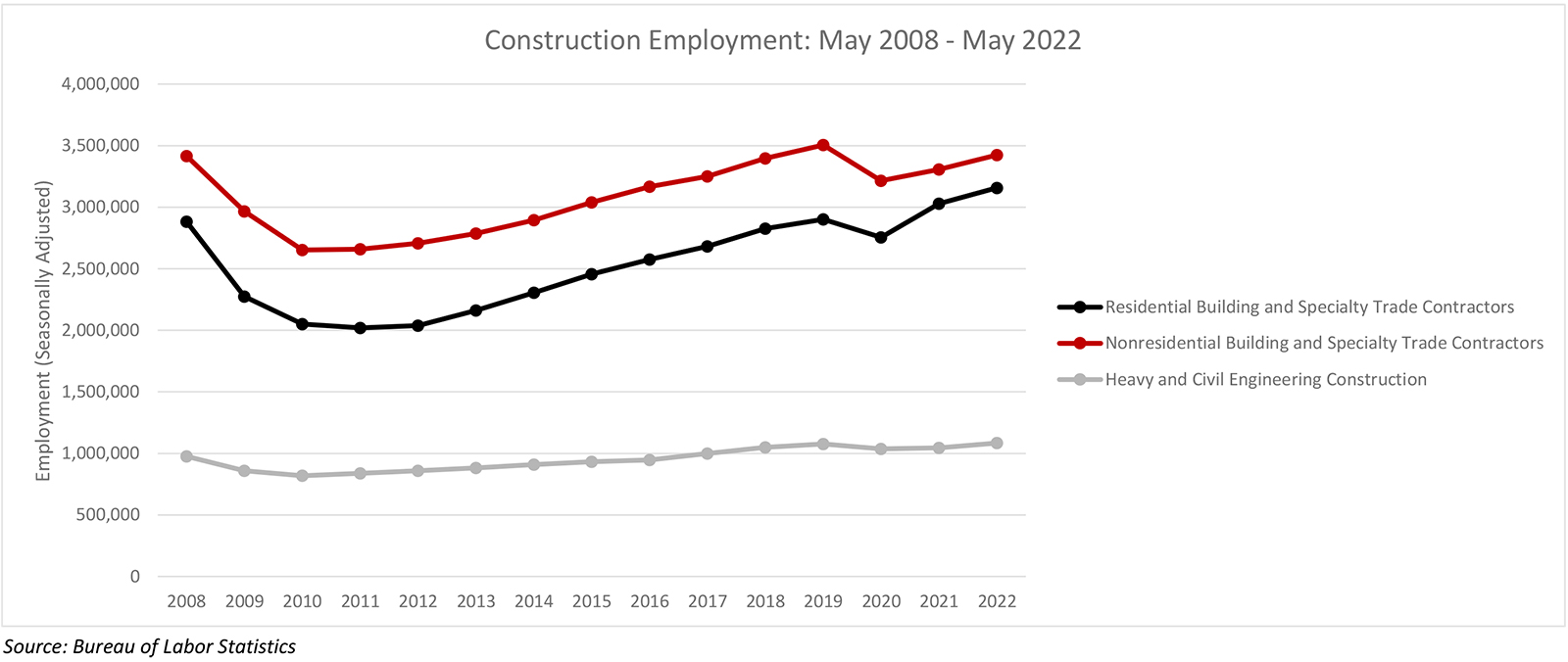
According to data released Friday by the US Bureau of Labor Statistics, the national construction industry added 36,000 jobs on net in May.
Key Takeaways
- The construction industry added 36,000 jobs on net in May.
- Nonresidential construction employment increased by 19,400 positions on net, with all three subsectors showing growth.
- “Many will view today’s somewhat weaker jobs report as bad news, but for contractors, this may turn out to be highly positive."

Press Release from Associated Builders and Contractors, Inc (ABC)
ABC: Nonresidential Construction Adds 19,400 Jobs in May
WASHINGTON, June 3—The construction industry added 36,000 jobs on net in May, according to an Associated Builders and Contractors analysis of data released today by the U.S. Bureau of Labor Statistics. On a year-over-year basis, industry employment has expanded by 283,000 jobs, an increase of 3.8%.
Nonresidential construction employment increased by 19,400 positions on net, with all three subsectors showing growth. Heavy and civil engineering added 11,300 net new jobs, while nonresidential specialty trade contractors added 5,700. Nonresidential building also added 2,400 new positions.
The construction unemployment rate decreased to 3.8% in May. Unemployment across all industries remained unchanged at 3.6% last month.
“If we look at a single data point, it appears that the nation is entering a period of slower job growth,” said ABC Chief Economist Anirban Basu. “Today’s estimate reveals job growth has finally fallen below the threshold of 400,000 new jobs a month. It is unclear whether this is primarily due to a lack of workers available to fill open positions or employers balking at high and rising wages. In either case, the implication is that consumer spending power will not expand as rapidly in the months ahead, setting the stage for softer economic growth and eventually slower inflation.
“In economics, it is often the case that bad news is good news and vice versa,” said Basu. “Many will view today’s somewhat weaker jobs report as bad news, but for contractors, this may turn out to be highly positive. To the extent that the economy slows, the Federal Reserve may decide not to raise interest rates as aggressively, at least once the summer is past. That will help moderate increases in the cost of capital, contributing to ongoing demand for construction services, which has slipped in the most recent month, according to ABC’s Construction Confidence Index.”
Press Release from Associated General Contractors of America (AGC)
Association Officials Push for New Construction Training Programs & Immigration Reforms as Labor Shortages Lead to Record Job Openings that are Undermining Construction Activity
Rapidly rising hourly earnings enabled the construction industry to add 36,000 employees in May, but a record number of job openings going into the month suggests contractors want to hire even more workers, according to an analysis by the Associated General Contractors of America of new government data. Association officials said firms would have hired even more workers if they could find more people willing to work in the sector.
“It is encouraging that contractors were able to add workers in May, but they will need many more to meet the increasing demand for infrastructure and private nonresidential projects,” said Ken Simonson, the association’s chief economist. “Despite steeply rising pay for hourly workers, job openings in construction hit an all-time high at the end of April, while the industry’s low unemployment rate suggests experienced workers are scarce.”
Average earnings for production and nonsupervisory employees—mainly hourly craft workers in construction —rose by 6.3 percent from May 2021 to last month, the most since December 1982, Simonson pointed out. But average earnings in the overall private sector rose slightly faster, by 6.5 percent, making it hard for contractors to attract enough applicants to fill all openings. There were 494,000 construction-industry job openings at the end of April, a jump of 141,000 or 40 percent from April 2021. That was the largest total for any month since that series began in 2000, Simonson added, citing government data released on Wednesday.
The unemployment rate among jobseekers with construction experience tumbled from 6.7 percent in May 2021 to 3.8 percent last month, the economist noted. The number of unemployed construction workers fell by 250,000 or 39 percent to 392,000, suggesting there are few experienced jobseekers left to hire.
Total construction employment moved up by 36,000 employees to 7,664,000 in May, with gains in each part of the industry. Employment in residential construction rose by 16,700 workers, including 5,000 employed by homebuilders and multifamily general contractors and 11,700 at residential specialty trade contractors. Nonresidential firms added 19,400 employees, including 2,400 at general building contractors, 5,700 at nonresidential specialty trade contractors, and 11,300 at heavy and civil engineering construction firms.
Association officials cautioned that the lack of available workers is undermining construction activity. They urged public officials at all levels to put in place more training programs to expose high school students and adults to career opportunities in construction. They also called on Congress and the Biden Administration to allow more workers with construction skills to legally enter the country.
"There is no shortage of available, good-paying career opportunities in the construction industry,” said Stephen E. Sandherr, the association’s chief executive officer. “Public officials should be exposing people to construction career opportunities that pay well and don’t require a college degree and the debt that all too often comes with it.”













